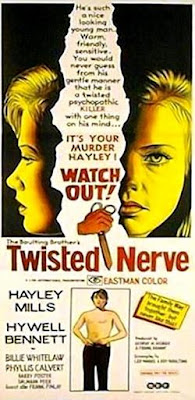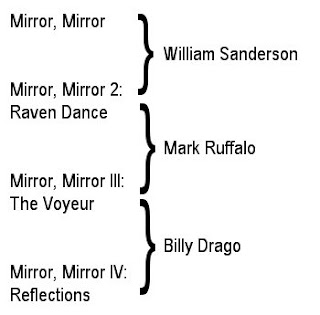 Somebody stop me buying cheap horror videos on eBay. I can’t help myself... Is there a number I can call? Can I perhaps Dial: Help?
Somebody stop me buying cheap horror videos on eBay. I can’t help myself... Is there a number I can call? Can I perhaps Dial: Help?What’s that? There’s a cheap horror video with that name? What am I waiting for?! Buy! BUY!!
No Italian horror film from those long-ago 1980s is complete without a tie-in pop song, and this silly effort from Cannibal Holocaust director Ruggero Deodato is no exception. “Baby, don’t answer... Baby, don’t answer the telephone,” warns the catchy chorus, as a spooky voice mumbles something about not being safe on the phone and/or your own. As it happens, our heroine Jenny (played by English model Charlotte Lewis) is neither; for several days now, she’s been trying to get through to her long-distance lover, Marco, to no avail. Now, sneaking into a cafe late at night to use the telephone, she gets a crossed line with a long-deserted helpline number and, before long, finds herself plagued at home by sinister calls and strange messages.
At least, I think they’re supposed to be strange. The sound was so muffled on the ancient video cassette I saw, that everything sounded a bit strange, but this may have had as much to do with the quality of the script as the sound levels. Take, for example, a top scientist’s explanation of the unfurling events: “The energies of love and hate circulate throughout the universe. Under the right conditions, they condense and concentrate themselves within a room, and those deposits of energy seek a way out. They can be so powerful as to magnify and seduce the person who’s liberated them.” Pretty scary, huh? Especially coming from, as one character puts it, “the world’s greatest expert on unidentified energy”.
 Matters aren’t helped by the fact that Jenny – poor, unwitting victim of the 1980s as she is – already owns several of the scariest-looking “fashion” phones in existence, including a black contraption with pulsing lights straight out of Knight Rider, and a lilac neon-filled number that looks like it could electrocute a fly at fifty paces... Hardly the likeliest conduits for a quiet conversation with your mum! Anyway, soon the supernatural telephonic forces have graduated from leaving creepy messages to causing the mysterious deaths of everyone Jenny knows. How does a phone kill anyone, you ask? Try these on for size:
Matters aren’t helped by the fact that Jenny – poor, unwitting victim of the 1980s as she is – already owns several of the scariest-looking “fashion” phones in existence, including a black contraption with pulsing lights straight out of Knight Rider, and a lilac neon-filled number that looks like it could electrocute a fly at fifty paces... Hardly the likeliest conduits for a quiet conversation with your mum! Anyway, soon the supernatural telephonic forces have graduated from leaving creepy messages to causing the mysterious deaths of everyone Jenny knows. How does a phone kill anyone, you ask? Try these on for size:- Watch out! Telephones may attempt to strangle you with their cables!
- You may receive phone calls compelling you to jump off a building whilst in a trance!
- The high-pitch squeaking tones they emit are enough to kill a whole tank of fish!
- When cornered, a phone will fling its dial at you like a deadly discus!
- Don’t forget, phones have been known to levitate and stalk you around your apartment!
- You are at particular risk when bathing. The phone will leap into the bath and burst into flames!
- Take care if you wear a pacemaker. Phones may cause it to burst through your chest!
- Payphones are particularly dangerous, as they can shoot out lethal coins at bullet-speed!
Well, if that’s not enough to put you off calling those premium-rate numbers for good, I don’t know what is. By the end of this film, you may well be telephonophobic. Or something.
With its surprisingly well thought-out premise, Dial: Help remains engaging (geddit?) throughout. There are enough wacky details to please any connoisseur of eighties cheese, from the decor of Jenny’s apartment (giant photos of lips eating spaghetti) to the delights of the local nightclub (jazz flute and a mime-artist-cum-disco dancer). But there’s also a lack of urgency, not to mention anything even bordering on scary. Props to the film for really trying to turn the telephone into an object of fear – there’s even an attempted shock moment where a telephone LUNGES into shot, only to be revealed as a toy phone in the hands of an overly eager toddler – but the problem is, no matter how quickly they LUNGE, phones just aren’t that frightening. Charlotte Lewis’s laidback performance works both for and against the film: on the one hand, her breezy delivery gives some of the sillier dialogue an almost naturalistic credibility; on the other, seeing her calmly approach a policeman after a night of terror-phone chaos, only to utter the line, “Excuse me, I’d like to report some deaths,” is just flat-out laughable. It’s also never made completely clear whether the phones are out to harm Jenny, protect her, or something else entirely... In fact, one scene has her rolling around the carpet, apparently being gently caressed into orgasm by gusts of wind coming out of her handset. I had to wonder what the girl would make of a hairdryer.
Charlotte Lewis’s laidback performance works both for and against the film: on the one hand, her breezy delivery gives some of the sillier dialogue an almost naturalistic credibility; on the other, seeing her calmly approach a policeman after a night of terror-phone chaos, only to utter the line, “Excuse me, I’d like to report some deaths,” is just flat-out laughable. It’s also never made completely clear whether the phones are out to harm Jenny, protect her, or something else entirely... In fact, one scene has her rolling around the carpet, apparently being gently caressed into orgasm by gusts of wind coming out of her handset. I had to wonder what the girl would make of a hairdryer.
Dial: Help isn’t a direct line to disaster, then, but don’t be too surprised if it doesn’t manage to push many of your buttons. I’m dialling D for Disappointing.
Rating: 2/5


















































